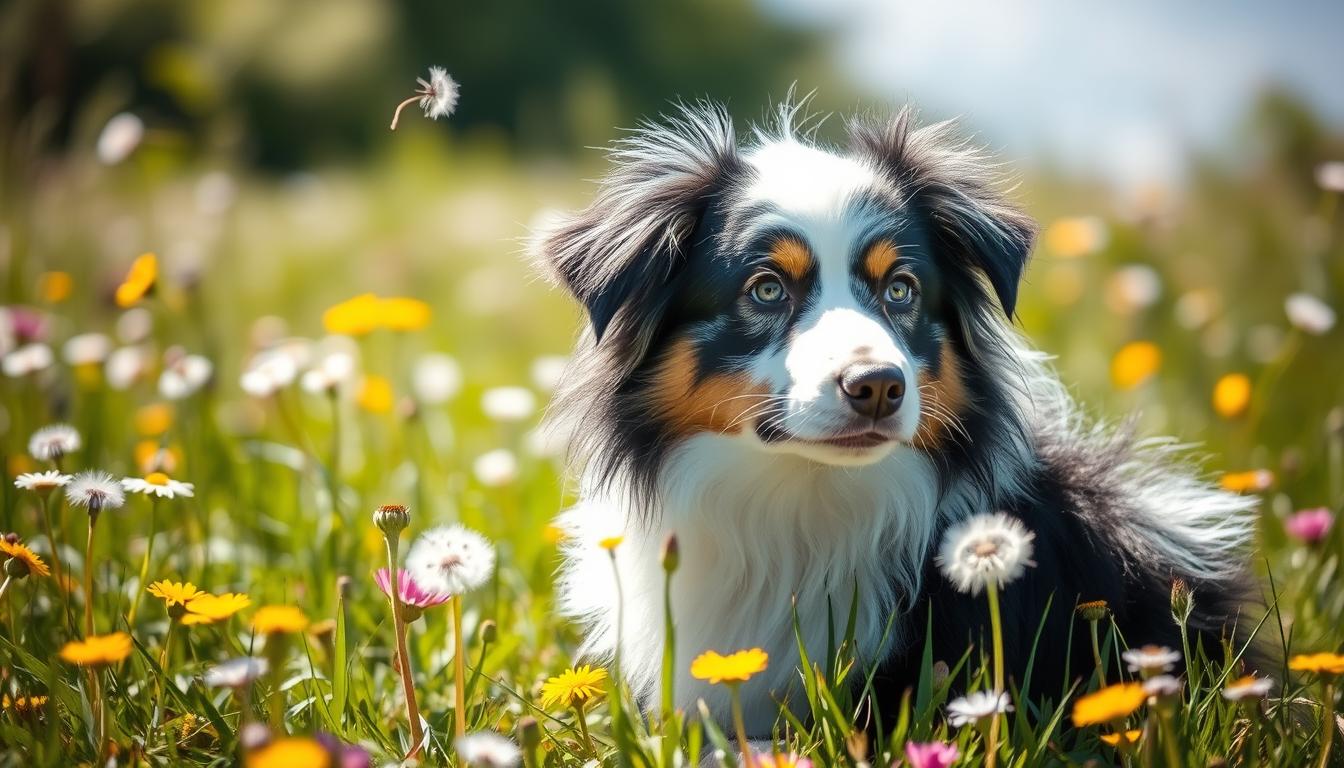Many people with allergies wonder if Australian Shepherds are hypoallergenic. The answer is not simple. These dogs are smart and great at herding. But, they have a thick double coat that makes them hard for allergy sufferers.
Knowing what hypoallergenic means is key. It’s also important to understand the Australian Shepherd’s traits. This helps when deciding to bring one home.
In this article, we’ll look at dog allergies and what makes a dog hypoallergenic. We’ll also talk about options for those who love Australian Shepherds but worry about allergies.
Key Takeaways
- Australian Shepherds are not hypoallergenic due to their thick double coat, which sheds significantly.
- Dog shedding spreads allergens like dander and saliva, making allergies worse for sensitive individuals.
- No dog is entirely hypoallergenic, but certain breeds are better suited for allergy sufferers.
- Regular grooming and vacuuming can help manage allergens in a dog-friendly home.
- Consider breeds like Poodles or Soft-Coated Wheaten Terriers if you are an allergy sufferer who loves herding dogs.
Understanding Hypoallergenic Dogs
The term hypoallergenic often creates misconceptions among dog lovers. Many people think these dogs don’t cause dog allergies. But, no dog is completely free from allergens.
These breeds usually have less pet dander or shed less fur. This means they are less likely to cause allergic reactions. Knowing about different dog breeds helps find the right one for allergy sufferers.
The Australian Shepherd is not considered hypoallergenic. It sheds moderately, needing regular grooming. This helps manage allergens at home.
Australian Shepherds come in many colors like Merle, Black, and Red. Their shedding can still affect those with allergies.
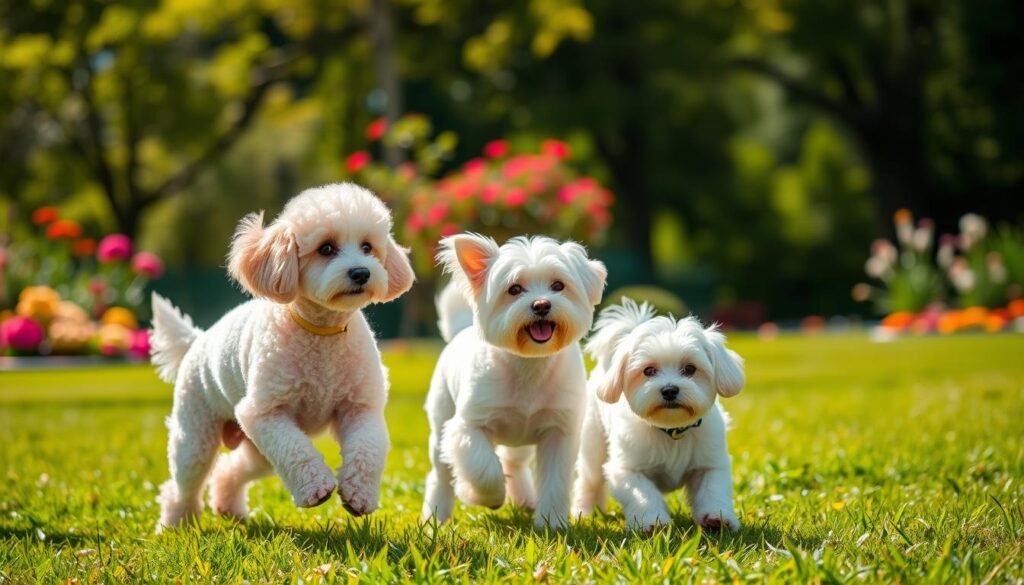
For those looking for hypoallergenic dogs, consider the Bichon Frise, Afghan Hound, and Schnauzer. They produce fewer allergens or have non-shedding coats.
Poodles and Portuguese Water Dogs are also good choices. They are known to be friendly and have low allergen levels.
Hypoallergenic crossbreeds like the Golden Doodle and Labradoodle are popular. They have lower allergen levels and are friendly. The Boxerdoodle, a mix of a Boxer and a Poodle, is another option. It’s smaller and suitable for those with allergies.
Adopting from local animal shelters is a good idea. It’s better than buying from breeders.
| Hypoallergenic Breeds | Allergen Level | Shed Type |
|---|---|---|
| Bichon Frise | Low | Low dander |
| Afghan Hound | Low | Non-shedding |
| Schnauzer | Low | Hypoallergenic coat |
| Poodle | Low | Non-shedding |
| Boxerdoodle | Low | Variable, non-shedding potential |
What Makes a Dog Hypoallergenic?
Understanding allergies is key when looking at hypoallergenic dogs. Many people react to proteins in dog saliva, urine, and dander, not fur. Knowing this helps pick the right dog breed.
Dog coat types matter a lot for allergies. Short-haired and low-shedding dogs are better for allergy sufferers. Double-coated dogs, like Australian Shepherds, shed more and spread allergens around the house.
The American Kennel Club (AKC) lists nine dog coat types. Some, like wiry, curly, or corded coats, cause fewer allergies. While no dog is completely hypoallergenic, some breeds are better than others. Poodles and schnauzers are often good choices for those with allergies.
To manage allergies, grooming and washing dog bedding weekly helps. Using air purifiers also reduces dander and fur.

| Dog Coat Type | Allergen Production | Suitability for Allergy Sufferers |
|---|---|---|
| Double-Coated | High | Less suitable |
| Wiry | Low | More suitable |
| Curly | Low | More suitable |
| Corded | Low | More suitable |
| Short-Haired | Variable | Conditional |
| Long-Haired | Moderate | Conditional |
Choosing a dog needs careful thought. Spend time with breeds to see how you react. While no dog is completely hypoallergenic, some are better for those with allergies.
An Overview of the Australian Shepherd Breed
The Australian Shepherd is a breed that many find captivating. It has a striking look and a lively personality. Even though its name suggests it comes from Australia, it actually started in the United States. Knowing the Australian Shepherd characteristics can help you see if it fits your lifestyle.
Australian Shepherds are medium-sized dogs. They weigh 40-65 pounds and are 18-23 inches tall. They live about 12-15 years and are very smart and full of energy. They need lots of exercise, about 1-2 hours a day.
They have a medium to long coat in many colors like blue or red merle, black, and tri-color. They shed a lot, so grooming is important. They can also have health issues like hip dysplasia, cataracts, and epilepsy.
Eye color can be very interesting, with some having two different colors or a split eye. They are very easy to train. This makes them great for herding, agility, and obedience training.
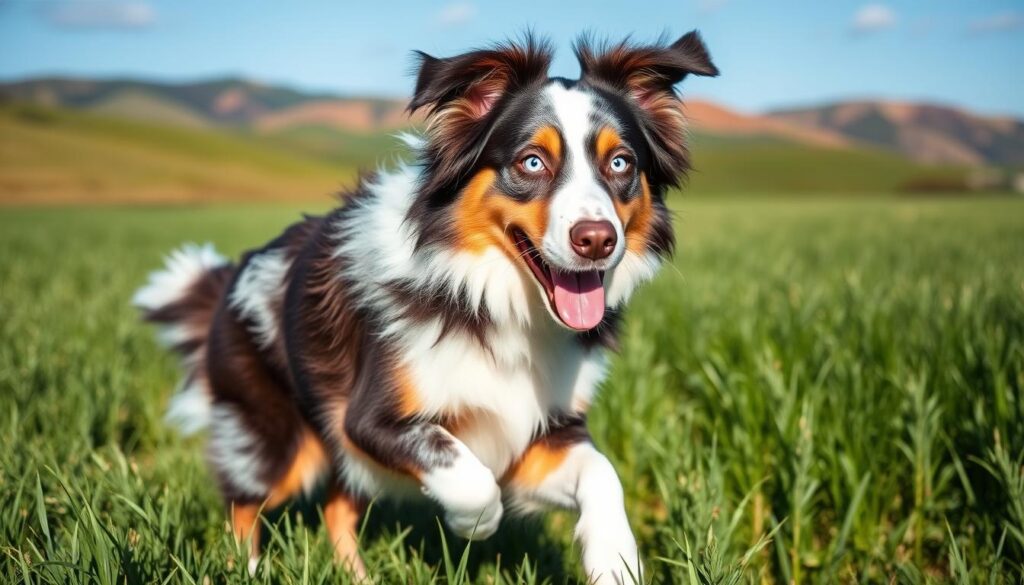
Getting an Australian Shepherd can cost between $15,000 to $20,000. This includes food, training, and healthcare. Insurance costs can be $40 to $60 a month, based on age and coverage.
Australian Shepherds are lively and smart. They bring joy and companionship to those who are active. My experience with them shows they make a great bond with their owners and add to a fulfilling life.
Are Australian Shepherds Hypoallergenic?
I think it’s key to talk about if Australian Shepherds are hypoallergenic. They are not because of their thick double coat. This coat sheds a lot all year, making homes messy for people with allergies.
Coat Characteristics of Australian Shepherds
The Australian Shepherd has two coats. The outer one is water-resistant, and the soft undercoat keeps them warm. But, this coat also makes them shed a lot. Brushing them every day helps keep hair and allergens down.
Shedding Patterns and Allergens
Australian Shepherds shed a lot. They shed more in winter and spring, making it hard to keep homes clean. The main allergens are in their urine, saliva, and dander. So, cleaning and grooming are key to reduce allergies.
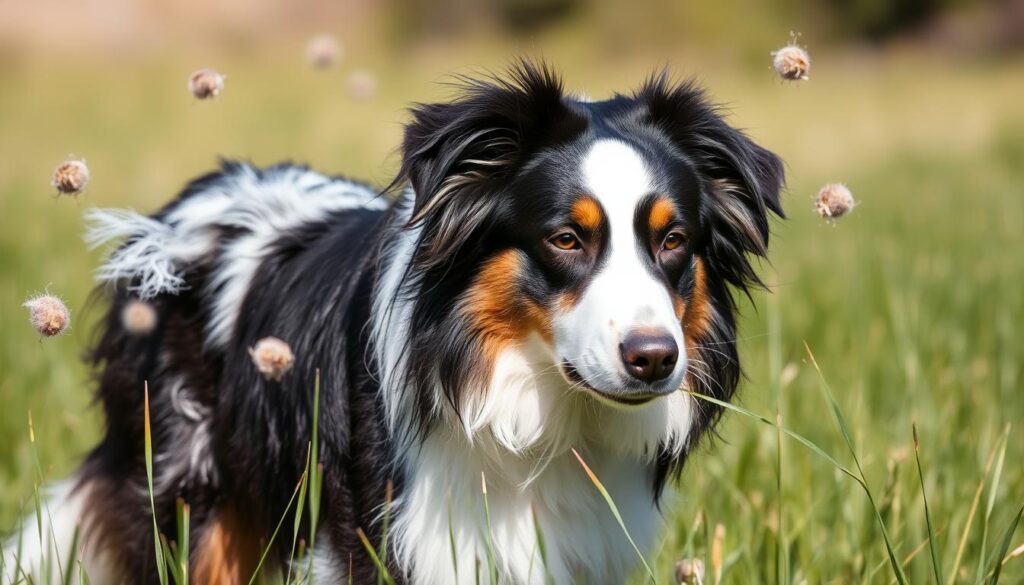
| Characteristic | Detail |
|---|---|
| Coat Type | Double coat (outer coat and undercoat) |
| Shedding | Heavy shedding year-round |
| Allergen Sources | Urine, saliva, and dander |
| Recommended Grooming | Daily brushing |
| Allergy Sufferer Impact | Significant potential for reactions |
The Science Behind Dog Allergies
Understanding dog allergies means looking into dog allergy science. About 10 percent of people in the United States have dog allergies. These allergies come from protein allergens in dog saliva, urine, and dander.

Australian Shepherds are not hypoallergenic dogs. Their shedding spreads dander everywhere, making allergies worse. Each dog has its own proteins, making it hard to guess who will react to them.
Male Australian Shepherds weigh 55 to 70 pounds. Females weigh 35 to 55 pounds. They are about 21 inches tall. Their colors include merle, black, and tri-color, making them look great.
No dog is completely hypoallergenic. Even Poodles, thought to be less allergenic, have lots of protein allergens. A 2011 study found no big difference in allergen levels between homes with hypoallergenic dogs and those without.
If you have allergies and want an Australian Shepherd, take steps to make it work. Groom them weekly to control shedding. Try living with one first to see if it’s a good fit.
Double-Coated Dogs and Allergies
Double-coated dogs can be tough for people with allergies. Breeds like the Australian Shepherd have two fur layers. This means they shed a lot, especially when it gets warmer.
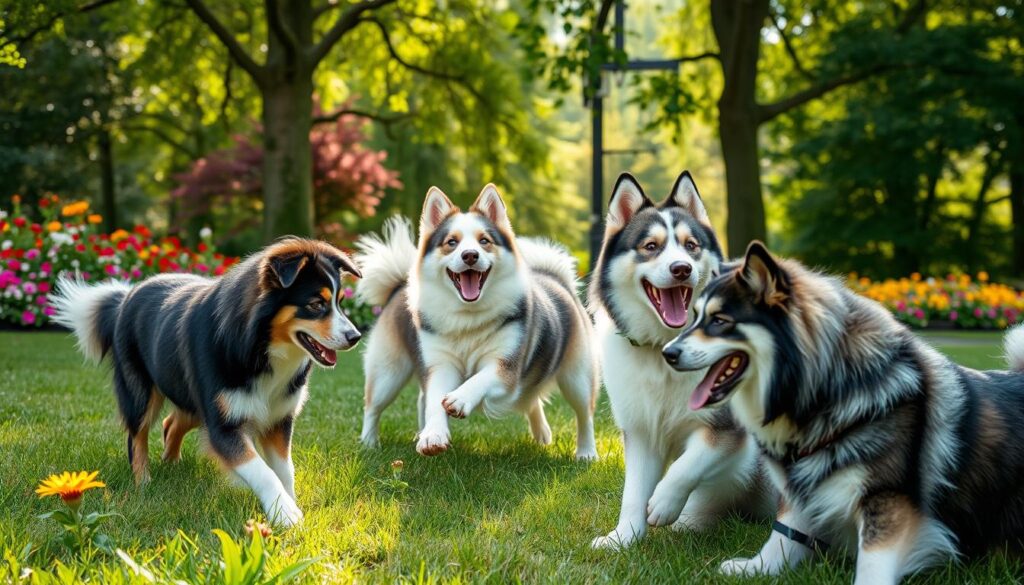
Shedding makes more allergens in your home. This can make allergies worse. Dog fur itself isn’t the problem. It’s what it catches from the air that’s the issue.
About 10 to 20% of people are allergic to pets. Knowing how dog shedding affects allergies is key. This is especially true for double-coated dogs like Australian Shepherds.
Studies show 30% of people with allergies or asthma get worse symptoms from pets. Double-coated dogs, including Australian Shepherds, can make allergies worse. But, with the right care, you can manage these issues.
| Characteristic | Double-Coated Dogs | Single/Curly-Coated Dogs |
|---|---|---|
| Shedding Amount | High | Low |
| Allergen Release | Higher risk | Lower risk |
| Examples | Australian Shepherds, Huskies, German Shepherds | Poodles, Bichon Frises, Afghan Hounds |
| Best for Allergy Sufferers | Not recommended | Often better choice |
Thinking about these points when picking a dog can make your home more comfortable for those with allergies.
The Best Dogs for Allergy Sufferers
Living with dog allergies can be tough. But, picking the right breed can make things better. Some breeds make less dander and shed less. This makes them good for people with allergies.
These hypoallergenic dog breeds have coats that don’t shed much. This is great for people who are very sensitive.
Here are some good options:
- Poodle: Poodles come in different sizes. They have low-shedding coats, making them perfect for allergies.
- Portuguese Water Dog: They have a coat that keeps water out. They love being outside and are great for active people.
- Soft Coated Wheaten Terrier: They are very energetic. Their soft coat makes little dander.
- Bichon Frise: They are small and have curly coats. They are great for people with allergies.
- Labradoodle: A mix of Lab and Poodle. They are low-shedding and loved by families.
- Chinese Crested: They come in two types: hairless and powderpuff. Both are good for people with allergies.
Getting a low-shedding dog means you need to groom them often. Brushing and bathing them can help. Also, wash pet bedding often and get rid of heavy carpets.

With the right dog and care, people with allergies can have pets. Finding the right dog can bring joy, even with allergies.
How to Manage Allergies Around Dogs
Living with a dog can be tough for people with allergies. It’s important to manage dog allergies well. Keeping your home clean and grooming your dog right helps a lot.
Grooming Tips for Owners
Regular grooming is key to controlling dander and hair. Here are some tips:
- Brush your dog often to get rid of loose hair and dander. Use tools that cut down on allergens.
- Give your dog baths to keep allergens off their coat. Use shampoos that are good for allergies.
- Get professional grooming if you can. It keeps you from getting too close to allergens.
Home Cleaning Solutions
Keeping your home clean is vital for dog allergy management. Here are some tips:
- Vacuum often, especially where people walk a lot. Use a vacuum with a HEPA filter to catch allergens well.
- Wash bedding, blankets, and pet covers every week to get rid of dander and hair.
- Dust with a damp cloth to stop allergens from flying around.
- Think about air purifiers with HEPA filters to cut down on airborne allergens.
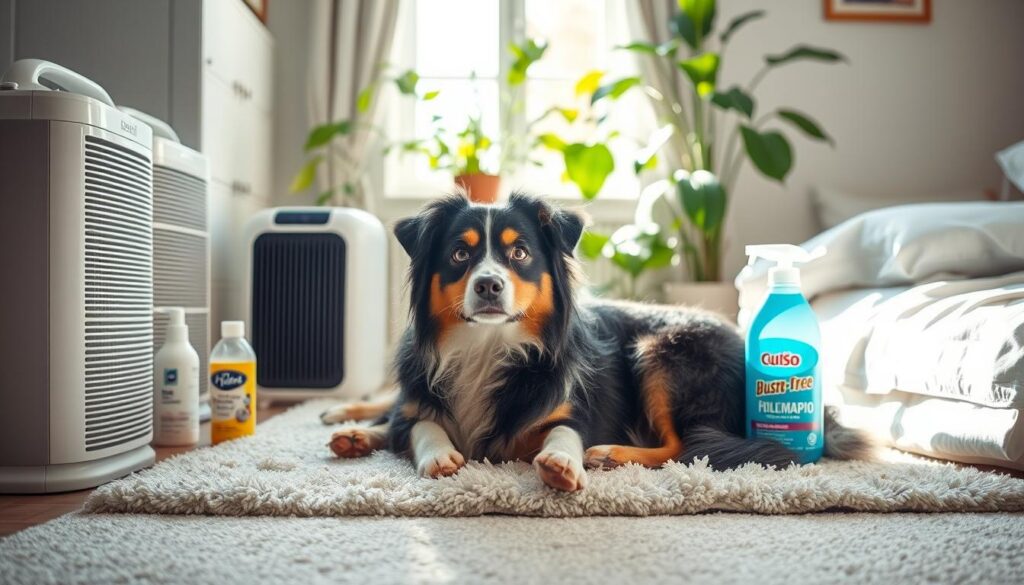
By following these grooming and cleaning tips, you can make your home better for dog allergies. This way, you and your dog can live happily together.
Coping with Dog Allergies and Lifestyle Changes
Living with dog allergies can be tough. But, there are ways to make life better. Changing your lifestyle helps a lot. Using air purifiers also makes your home cleaner.
Utilizing Air Purifiers
Air purifiers are great for dog allergy sufferers. They catch pet dander and other allergens. This makes the air cleaner.
Here are some tips to go with air purifiers:
- Make dog-free zones in your home for cleaner air.
- Get HEPA filter air purifiers to remove allergens well.
- Take your dog to the vet often to check their health.
- Try a hypoallergenic diet for your dog if they have food allergies.
- Brush your dog often to cut down on dander.
By making these lifestyle changes, you can have a dog and still feel good. A balanced home is key for both pets and people to be happy together.

Common Allergic Reactions to Dogs
Many people get dog allergy symptoms when they’re near dogs, especially those with thick fur like Australian Shepherds. These dogs shed a lot and can make people sick. Symptoms include:
- Sneezing and nasal congestion
- Itchy and watery eyes
- Skin rashes or hives
- Respiratory issues such as wheezing and coughing
How people react to dog allergies can be different. Some might feel a little uncomfortable, while others could have serious problems. Knowing what allergies you have can help you deal with them better.
When thinking about getting a dog, it’s important to know about their fur. Dogs with thick fur, like Australian Shepherds, shed a lot. This makes them bad for people with allergies, especially in spring and fall.

There are other dogs that might be better for people with allergies. Dogs with less fur, like Soft-Coated Wheaten Terriers, Poodles, and Portuguese Water Dogs, are better. They don’t shed as much. Choosing the right dog and making some changes can make your home more comfortable for you and your pet.
| Dog Breed | Coat Type | Suitability for Allergy Sufferers |
|---|---|---|
| Australian Shepherd | Double Coat | Not Suitable |
| Soft-Coated Wheaten Terrier | Wavy and Silky | Suitable |
| Poodle | Curly | Highly Suitable |
| Portuguese Water Dog | Curly/Wavy | Suitable |
| Miniature Schnauzer | Wiry | Suitable |
Alternatives to Australian Shepherds for Allergy Sufferers
If you have allergies but want a pet, there are good options. Many breeds are dog breeds for allergies and are great for people with allergies. Here are some popular ones:
- Bichon Frise: This breed has a special coat that helps keep homes clean.
- Poodles: They come in different sizes and are very popular for being non-shedding dog breeds.
- Yorkshire Terrier: Their hair is like human hair, so it’s less likely to cause allergies.
- Maltese: They have all-white coats that need regular grooming to stay hypoallergenic.
- Portuguese Water Dog: They are medium-sized and great for people living in apartments.
- West Highland Terrier: They shed very little and are very lively.
- Havanese: Their low-shedding coats are easy to take care of.
- Cairn Terrier: They have wiry coats that are good for people with allergies.
- Coton de Tulear: Known as the “royal dog of Madagascar,” they have soft, white hair that’s less likely to cause allergies.
- Irish Water Spaniel: They have water-repelling coats and love water.
Choosing a hypoallergenic alternative can really improve life for people with allergies. These breeds shed less than Australian Shepherds. This means there are fewer allergens around.
| Breed | Characteristics | Shedding Level |
|---|---|---|
| Bichon Frise | Hypoallergenic, playful | Minimal |
| Poodle | Hypoallergenic, intelligent | Non-shedding |
| Yorkshire Terrier | Fine hair, affectionate | Minimal |
| Maltese | Grooming-friendly | Minimal |
| Portuguese Water Dog | Adaptable, active | Minimal |
| West Highland Terrier | Curious, lively | Minimal |
| Havanese | Low-shedding, playful | Minimal |
| Cairn Terrier | Wiry coat, energetic | Minimal |
| Coton de Tulear | Soft, loving | Minimal |
| Irish Water Spaniel | Water-repelling, friendly | Minimal |

How to Choose the Right Dog for Your Allergies
Looking for the right dog with allergies is a big task. It’s important to pick dogs that don’t make you sick. I learned to spend time with different dogs before deciding.
Some dogs don’t shed much or have special hair. This helps keep allergens away from you.
Talking to allergists is key. They give advice based on your allergies. They say some breeds are better for people with allergies.
Choosing the right dog can be hard. But, think about how much they shed. Dogs that shed less might be better for you.
No dog is completely safe from allergies. But, some dogs are easier to live with. Their coats can help keep allergens down.
Knowing your allergies helps too. Watch how you react to different dogs. This way, you can find a dog that’s good for you.
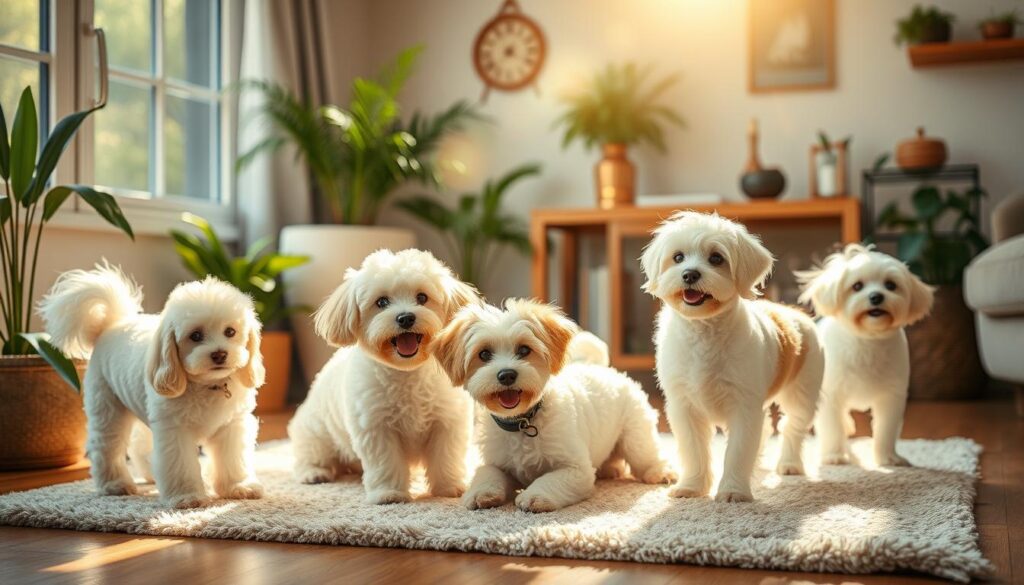
Conclusion
In this article, we talked about dogs and allergies. We looked at Australian Shepherds and if they are good for people with allergies. They are friendly and smart, but they shed a lot.
This shedding can make allergies worse. To help, grooming and keeping things clean are key. Brushing often, washing bedding, and using air purifiers can help a lot.
Finding a dog that doesn’t make allergies worse is hard. But, picking breeds that shed less can help. This can make a big difference.
It’s important to think carefully before getting a dog. Everyone’s allergies are different. Talking to an allergist before getting a pet is a good idea.
As we finish talking about Australian Shepherds, remember to think about your lifestyle and the dog’s needs. This will help you choose the best dog for your home.
